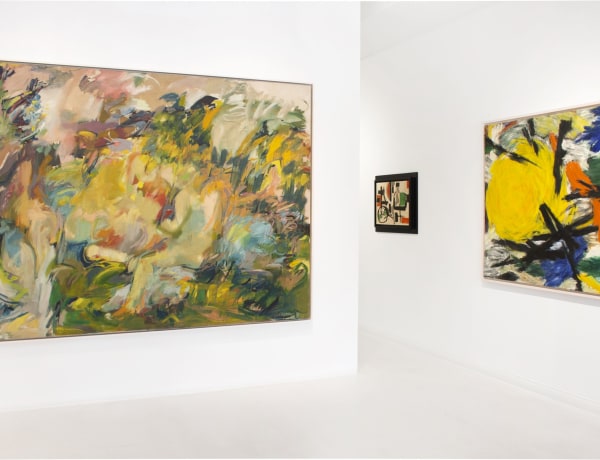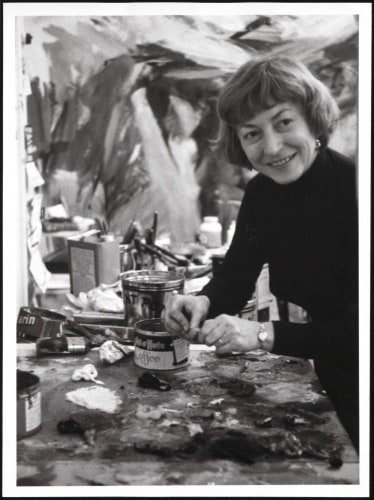

B. BROOKLYN, NEW YORK, 1918
D. SOUTHAMPTON, NEW YORK, 1989
Elaine de Kooning (b. 1918, Brooklyn, New York, d. 1989, Southampton, New York) was exposed to art through frequent museum and gallery visits with her mother from a young age. Shortly after enrolling at Hunter College, New York, she withdrew in 1937 and began studying art at the Leonardo da Vinci Art School in New York with Conrad Marca-Relli, who became a close friend. She also took drawing classes from the man who would eventually become her husband, Willem de Kooning, in 1938. While de Kooning frequently advertised the greatness of Willem de Kooning, she also pursued her own private and professional life, with an amalgam of spontaneity, improvisation, violence, and energy that matched the forces and style of action painting. Her early works are still lifes and portraits distinctly influenced by Cubism, but in the mid- to late 1940s she began making abstract paintings as well as writing art criticism. In 1948, she began worked as an editorial associate at Art News under Thomas Hess, writing essays on Arshile Gorky, Hans Hofmann, and Franz Kline, and making Abstract Expressionism accessible to a broader audience.
In the Summer of 1948, de Kooning spent two months at Black Mountain College near Asheville, North Carolina. The artist became concerned with aesthetic sophistication and organic unity as achieved by biomorphic, closed forms. Within this two-month period, De Kooning created a body of work featuring sixteen paintings. Her work displayed an unfocused quality of interlocking curves reflective of a harmonious interdependence of forms that were heavily influenced by the atmosphere at Black Mountain College. De Kooning was part of a community of faculty and students at the school formed a mutually enriching body of creative energy. When not busy with her own work, de Kooning spent here spare time interacting with her peers: she listened to Buckminster Fuller’s lectures on engineering, joined Josef Albers color theory class, and attended Merce Cunningham’s dance recitals and John Cage’s concerts. Though de Kooning found Black Mountain College to be resolve some to the difficulties that beset her earlier work – lack of compositional unity, dependence on representational references, and the inability to move beyond illusionistic structure—she also found her series at proved to be a dead end. De Kooning rolled up her paintings and kept them stored away for decades. After the summer, de Kooning sought challenges and became interested in the ways she could go beyond morphology.
Untitled is a small work created soon after de Kooning left Black Mountain College in 1949. That year, de Kooning began to write for Art News was also a founding member of the Club, a group of avant-garde artists that met in Greenwich Village to discuss and debate art from 1949 until 1962. Though small, the nature of the work is multidimensional in its numerous layers dominated by black and white paint, accented by strokes of pink and yellow. After the work was executed, Elaine de Kooning would firmly declare, “Flat painting is a great bore… A painting without black is like food without salt…We all have our problems. However, black solves all problems. Ask Franz. Ask his mother.” Untitled not only offers a world of layers, but also exhibits traces of emotion as told by the fervent streaks and excited drops that magnifies the canvas.
Though a fierce defender of Abstract Expressionism, she eventually became known for her portraits, particularly of men. In the late 1940s, De Kooning painted basketball players at play using a loose, expressionistic style. After receiving a teaching appointment at the University of New Mexico, Albuquerque, in 1958, she traveled to Ciudad Juárez, Mexico, where she saw her first bullfight. The experience inspired a series of bull paintings on horizontal canvases, rendered in a bolder palette than that of her previous work. In 1961 she was included in the Whitney Annual (later the Whitney Biennial), New York, and in 1962 was commissioned to paint John F. Kennedy’s portrait, in part because of her reputation for quick execution. Despite an entire year obsessively working on the portrait, after the president’s death in 1964 she ceased painting altogether for another year. During the 1980s, she made a series of quasi-figurative, orgiastic paintings titled Bacchus. In 1983 she visited the Paleolithic caves in Lascaux, France, and began a series of paintings based on the cave paintings, titled Cave Walls, in which outlines of animals such as deer, bison, and goats, are rendered against turbulent grounds of dense brushstrokes.
Toward the end of her life, she also made a number of works on paper in ink, continuing with the theme of cave paintings. De Kooning had several solo gallery shows throughout her lifetime at museums including the Montclair Art Museum, New Jersey (1973), and Guild Hall Museum, East Hampton, New York (1989). Her work was featured in the Museum of Modern Art–organized exhibition, Young American Painters (1956–58), which traveled throughout the United States (but was not presented in New York). De Kooning was also included in group shows at Walker Art Center, Minneapolis (1956); Pittsburgh International (now Carnegie International, 1956); Art Institute of Chicago (1964); Hirshhorn Museum and Sculpture Garden, Washington, DC (1980); and Guild Hall Museum, East Hampton (1990).